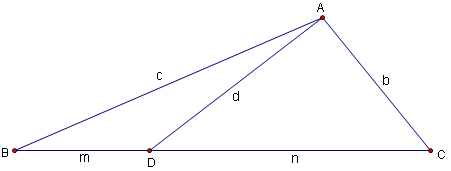Stewart's Theorem
Contents
[hide]Statement
Given any triangle ![]() with sides of length
with sides of length ![]() and opposite vertices
and opposite vertices ![]() ,
, ![]() ,
, ![]() , respectively, then if cevian
, respectively, then if cevian ![]() is drawn so that
is drawn so that ![]() ,
, ![]() and
and ![]() , we have that
, we have that ![]() . (This is also often written
. (This is also often written ![]() , a phrase which invites mnemonic memorization, i.e. "A man and his dad put a bomb in the sink.") That is Stewart's Theorem.
, a phrase which invites mnemonic memorization, i.e. "A man and his dad put a bomb in the sink.") That is Stewart's Theorem.
Proof
Proof 1
Applying the Law of Cosines in triangle ![]() at angle
at angle ![]() and in triangle
and in triangle ![]() at angle
at angle ![]() , we get the following equations:
, we get the following equations:
Because angles ![]() and
and ![]() are supplementary,
are supplementary, ![]() . We can therefore solve both equations for the cosine term. Using the trigonometric identity
. We can therefore solve both equations for the cosine term. Using the trigonometric identity ![]() gives us
gives us
Setting the two left-hand sides equal and clearing denominators, we arrive at the equation: ![]() . However,
. However, ![]() so
so
![]() and
and
![]() This simplifies our equation to yield
This simplifies our equation to yield ![]() as desired.
as desired.
Proof 2 (Pythagorean Theorem)
Let the altitude from ![]() to
to ![]() meet
meet ![]() at
at ![]() . Let
. Let ![]() ,
, ![]() , and
, and ![]() .
.
We can apply the Pythagorean Theorem on ![]() and
and ![]() to yield
to yield
![]() and then solve for b to get
and then solve for b to get ![]()
Doing the same for ![]() and
and ![]()
![]() then solve for c to get
then solve for c to get ![]()
Now multiple the first expression by m and the second by n
![]()
![]()
Next add these two expressions
![]() .
.
Then simplify as follows (we reapply x + y = n a few times while factoring):
![]()
![]()
![]()
![]()
![]()
Rearranging the equation gives Stewart's Theorem:
![]()
Proof 3 (Barycentrics)
Let the following points have the following coordinates:
![]()
![]()
![]()
![]()
Our displacement vector ![]() has coordinates
has coordinates ![]() . Plugging this into the barycentric distance formula, we obtain
. Plugging this into the barycentric distance formula, we obtain ![]() Multiplying by
Multiplying by ![]() , we get
, we get ![]() . Substituting
. Substituting ![]() with
with ![]() , we find Stewart's Theorem:
, we find Stewart's Theorem: ![]()
Video Proof
See Also
This article is a stub. Help us out by expanding it.










